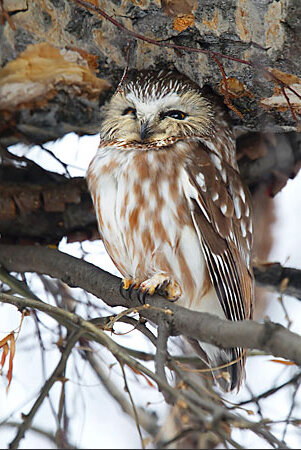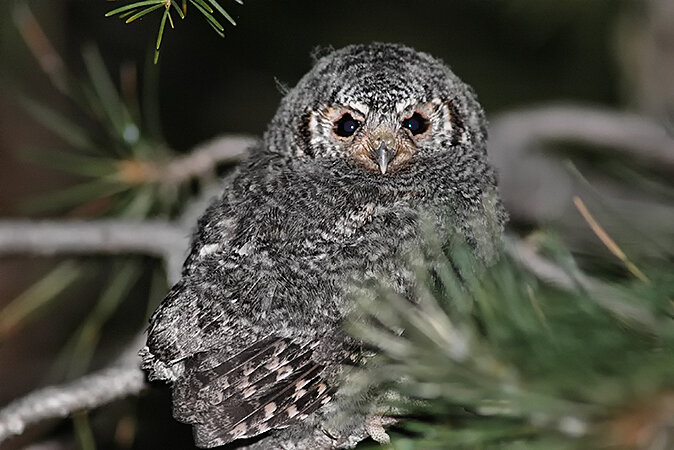Owl Banding with Scott Rashid
By Carol Kampert
“We’ve got one in the net…let’s move!”
Saturday evening Sept. 16, 2023, twelve folks gathered in a ranger building in Rocky Mountain National Park to spend an evening with rehabilitator, bander, author, artist, and researcher Scott Rashid. We were there at a BCAS Interludes with Nature workshop to observe small mountain owls up close as they were captured and banded for research purposes. Scott has federal and state permits to capture and band these birds.
We had arrived at the building in Hidden Valley at 6:00 PM but it was 9:30 PM before Scott saw the first video image of an owl in the mist net he had set up behind the building. By attaching a camera at the edge of the net, that was connected to a computer monitor inside the building, he was able to watch the nets continuously. When he saw the netted owl on the monitor, Scott pulled on a headlamp and rushed outside with his assistants in the dark to recover it. Holding it carefully in his hand, Scott brought the owl into the building where all the equipment he would need for measuring, weighing, recording, and banding was set up.
Scott Rashid with banded Boreal Owl. Photo by Carol Kampert.
It was a Boreal Owl (Aegolius funereus)! The largest of four small owls that nest in the mountains of Colorado. Only 10 inches long from head to tail, it is a stunningly lovely little owl when seen up close -- a large head, bright yellow eyes, and streaked and spotted feathers.
A young Boreal Owl (pictured) has dark brown plumage, while adult Boreal Owls have streaked brown plumage. Photo by Gerhard Assenmacher.
We learned that Boreal Owls nest in tree cavities – as do all the small mountain owls – and hunt after dark for small prey, such as voles, mice, and other small mammals. After recording all the data he needed for the owl and banding it, Scott took it outside and released it on a branch so it could fly away when it was ready.
At about 10:00 PM, just as we were ready to leave, Scott saw another owl on his monitor and brought it inside. This time it was a Northern Saw-whet Owl (Aegolius acadicus). At only 6 ½ - 8 inches long it is smaller than the Boreal Owl. Somewhat darker than the Boreal Owl, this tiny saw-whet had streaked feathers and bright yellow eyes. Its main prey is small mammals (preferably deer mice), song birds, and insects.
A Northern Saw-whet owl. Photo by Gerhard Assenmacher.
We were lucky to catch and observe two different owls in one night! The other two small mountain owls in Colorado are the Northern Pygmy Owl and the Flammulated Owl.
Northern Pygmy Owl. Photo by Gerhard Assenmacher.
Juvenile Flammulated Owl. Photo by Gerhard Assenmacher.
If you want to learn more about these little owls, a revised and expanded 2022 edition of Scott’s 335-page book, Small Mountain Owls, is now available directly from the author or on Amazon. It is brimming with beautiful photographs and paintings by Scott illustrating the four small mountain owls he has focused on, as well as detailed information and stories about each of the species.
Interludes with Nature is a special series of field trips, led by the area’s most knowledgeable birders and naturalists, that take participants to places they wouldn’t often get to see. The funds raised from Interludes support the scholarships to send BCAS Teen Naturalists (and other young birders in Colorado) to birding camps in Maine.
Interludes with Nature trips are not being planned for 2024.





